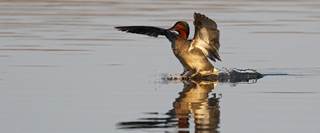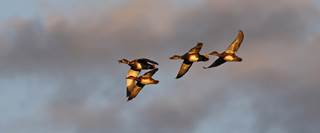Five Pacific Flyway Public Land Hotspots for 2020
Find ducks and geese on public land in the Pacific Flyway
Find ducks and geese on public land in the Pacific Flyway
The Pacific Flyway, from north to south, offers a great abundance of hunting opportunities. The following destinations are a handful of solid public hunting options for 2020.

The bulk of waterfowl hunters in western Washington focus their attention on north Puget Sound. However, plenty of good hunting is also available on the south Sound, between Olympia and Tacoma. One of the most popular public hunting areas is Billy Frank Jr. Nisqually National Wildlife Refuge, a large tidal delta located where the Nisqually River meets the Sound. The refuge is home to the least-disturbed river estuary in the state and includes both tribal and state-managed lands.
While much of the 4,500-plus-acre refuge is closed to hunting, several hundred acres in key areas are open during the season. Birds come in off the bay, says Kyle Spragens, waterfowl section manager for the Washington Department of Fish and Wildlife. But there arent a lot of walk-in sites for the public.
Spragens notes that with some precautions, hunters using small craft such as kayaks can effectively hunt the delta. The primary access point is at Luhr Beach boat launch, on the northwest edge of the refuge.
The one caveat to be aware of, he warns, is the combination of tides and prevailing afternoon winds, which can quickly turn a hunt sour. Guys out there pick a main drainage channel, Spragens explains. Most go across to the east or south into McAllister Creek.
Vegetation is so low on the delta that hunters often use canal banks for cover or brush up their own blinds, Spragens says. Be aware of where you can and cannot hunt, he adds. It is illegal to even retrieve downed birds in closed areas.
Youve got to know your boundaries, Spragens cautions.
For more information, visit fws.gov/refuge/billy_frank_jr_nisqually/.

While Idaho produces enough local ducks and geese to keep hunters occupied for the first couple weekends of the season, many eagerly look forward to around Thanksgiving, when they can take to the river. The Snake River, that is. This circuitous waterway meanders through Idahos richest agricultural lands, which draw ducks and geese to the vast surrounding plain through the dead of winter.
Hunters welcome the onset of hard November freezes, which challenge ducks and geese to find extra energy in farm fields and, especially, open water. The birds have access to hundreds of miles of resting and loafing spots on the Snake, a perfect setting for hunting by boat in the winter.
Most folks use jet boats, notes Jeff Knetter, upland game and migratory game bird coordinator for the Idaho Fish and Game. Indeed, the Snakes many shoals tend to chew up props. But all of the river in southern Idaho can be drifted. Like a lot of others, I use a canoe, he says.
The river is public up to the mean high-water mark, and theres almost always a place to hunt. Both jump-shooting and setting up with decoys are effective in the right places. While most of the river has relatively gentle current, there are a few treacherous areas with rapids, so Knetter advises hunters do their homework.
Weekdays are better than weekends, he says. Watch and learn duck and goose patterns of movement, and always respect private property.
Waterfowlers who dont own a boat can hunt several areas along the river with walk-in access, such as CJ Strike Wildlife Management Area.
Just over an hours drive from Boise and bordering a major reservoir, CJ Strike is a magnet for waterfowl, and nearly the entire area is open to hunting. For more information, visit idfg.idaho.gov/rules/migratory.

Oregons waterfowling traditions are rooted along the Columbia River. While hunters typically concentrate on the lower rivers estuary, many also hunt from Portland east, where nearly 150 miles of shoreline is open to duck and goose hunting (except, of course, for restricted areas within city limits, parks, refuges, and near dams). Tremendous numbers of mallards and Canada geese winter along the Columbia, and the waterway offers some of the best diver hunting in the flyway.
Theres a ton of shoreline access, observes Brandon Reishus, waterfowl manager for the Oregon Department of Fish and Wildlife. Boat hunters can typically set up almost anywhere.
Its important to note, however, that most of the Columbias islands are on the Washington side of the state line, so be sure you are in compliance with the appropriate states license requirements and regulations that apply where you hunt. Reishus also cautions hunters to venture onto the Columbia only with a seaworthy boat because high winds, waves, and current can make the river treacherous during winter. And he advises hunters to respect the boundaries of private property because trespassing to retrieve downed birds is illegal.
For more information, visit oregonhuntingmap.com/#/map.

More than 260 miles north of the Golden Gate bridge, Humboldt Bay is its own golden gateway for wintering waterfowl, a welcome respite from the rugged coastline and the only major bay between San Francisco and Coos Bay, Oregon.
Surrounded by rich pastureland, nearly a third of this 14-mile-long estuary (ranging from a half mile to four miles wide) consists of tidal flats containing some of the largest concentrations of eelgrass on the West Coast.
Even without grain crops, Humboldt Bays combination of habitats supports tens of thousands of ducks and geese every winter, beginning with the early arrival of teal, pintails, and wigeon followed by brant, mallards, shovelers, divers, and Aleutian cackling geese.
Dont tell anybody! begs Brendan Leigh, wildlife refuge specialist for Humboldt Bay National Wildlife Refuge.
Approximately half the 4,000-acre refuge is managed for wildlife, with hundreds of acres of public hunting available. The bay also has an additional 4,100 acres of state-managed wildlife areas open for both boat and walk-in hunting.
Kyle Spragens, Washingtons waterfowl section coordinator who obtained a degree from nearby Humboldt State, echoes Leighs enthusiasm for the area. Its by far the best controlled-draw hunt on the West Coast, Spragens proclaims. Hunt ducks in the morning and brant in the afternoon.
For more information, visit fws.gov/refuge/humboldt_bay/.

Arizona isnt often considered a waterfowl hunting hotspot, but it shouldnt be overlooked. Three major national wildlife refuges offer hunters a chance at an impressive array of birds.
Its a hidden gem overall, says Johnathan ODell, migratory bird coordinator for the Arizona Game and Fish Department. It doesnt get talked about much.
Imperial National Wildlife Refuge (NWR) is the farthest south of the three refuges, and although it contains wetland areas, other than parts of the river, the refuge receives little hunting pressure.
Havasu NWR is mostly a walk-in hunting area where reservations are required. However, securing a reservation allows you to hunt each day that the refuge is openon Saturday, Sunday, and Wednesday. Havasu NWR offers both goose and duck hunting opportunities, with snow geese and whitefronts in the mix. ODell says the refuge is also a reliable location to take blue-winged teal early in the season. Later, the area fills up with greenwings, pintails, mallards, wigeon, shovelers, scaup, and ringnecks.
Finally, theres Cibola NWR, which accounts for 25 to 40 percent of all the ducks harvested in the state each year. Hunting areas include the Island Unit, which offers first come, first served access; Hartline Marsh, which can be hunted by boat; and a tightly managed goose hunting unit, with access available via a weekly draw.
For more information, visit fws.gov/refuge/imperial/, fws.gov/refuge/havasu/, and fws.gov/refuge/Cibola/.
Ducks Unlimited uses cookies to enhance your browsing experience, optimize site functionality, analyze traffic, and deliver personalized advertising through third parties. By continuing to use this site, you agree to our use of cookies. View Privacy Policy